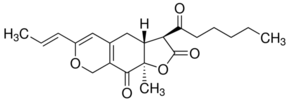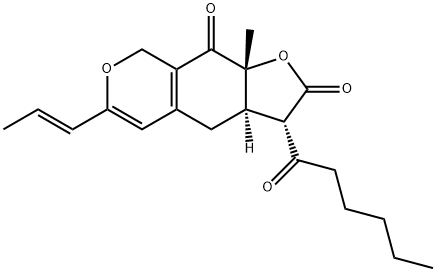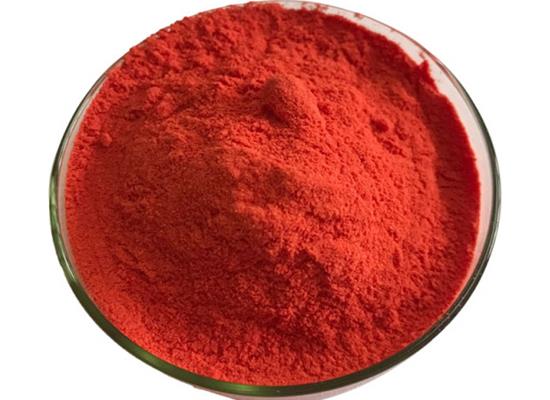What is Monascin, and what is it used in medical treatment?
Description
Monascin is an organic heterotricyclic compound that is 3a,4,8,9a-tetrahydro-2H-furo[3,2-g][2]benzopyran-2,9(3H)-dione that is substituted at positions 3, 6, and 9a by hexanoyl, (1E)-prop-1-en-1-yl and methyl groups, respectively. It is one of the azaphilonoid pigments in extracts of monascus pilosus-fermented rice (red-mold rice). It is a potent inhibitor of carcinogenesis measured against chemical or UV initiated, phorbol-promoted mouse skin tumors. It works as an antineoplastic agent to inhibit or prevent the proliferation of neoplasms, and antilipemic drug to treat hyperlipidemia [1].

Use
Intracerebral hemorrhage (ICH) is a particularly devastating form of stroke with high mortality and morbidity and hematomas are the primary cause of neurologic deficits associated with ICH. Monascin could treat neurological deficits, hematoma clearance and edema extinction in a model of intracerebral hemorrhage (ICH) in rats [2]. The products of hematoma are recognized as neurotoxins and the main contributors to edema formation and tissue damage after ICH. Finding a means to efficiently promote absorption of hematoma is a novel clinical challenge for ICH. Peroxisome proliferator-activated receptor gamma (PPARγ) and nuclear factor erythroid 2-related factor 2 (Nrf2), had been shown that, can take potential roles in the endogenous hematoma clearance. Monascin, a novel natural Nrf2 activator with PPARγ agonist, plays a key role in ICH and effects on neurological deficits, hematoma clearance and edema extinction in a model of ICH in rats.
Meanwhile, scientists investigated monascin to test whether this compound acts as an antidiabetic and antioxidative stress agent in diabetic rats and Caenorhabditis elegans [3] and the mechanisms by which monascin exerts its action in vivo were examined. Streptozotocin (STZ)-induced diabetic rats were given monascin at 30 mg/kg/day and sacrificed after 8 weeks. Blood glucose and serum insulin, triglyceride, total cholesterol, and high-density lipoprotein and antioxidative enzymes in the pancreas of rats were measured. In addition, monascin was evaluated for stress resistance and potential associated mechanisms in C. elegans. Throughout the 8-week experimental period, significantly lowered blood glucose, serum triglyceride, and total cholesterol and higher high-density lipoprotein levels were observed in monascin-treated rats. Monascin-treated rats showed a higher serum insulin level, lower reactive oxygen species production, and higher activities of glutathione peroxidase, superoxide dismutase, and catalase in the pancreas compared to diabetic control rats.
In addition, monascin significantly induced the hepatic mRNA levels of FOXO3a, FOXO1, MnSOD, and catalase in STZ-induced diabetic rats. Monascin-treated C. elegans showed an increased survival rate during oxidative stress and heat stress treatments compared to untreated controls. Moreover, monascin extended the life span under high-glucose conditions and enhanced expression of small heat shock protein (sHSP-16.2), superoxide dismutase (SOD-3), and glutathione S-transferase (GST-4) in C. elegans. Finally, scientists showed that monascin affected the subcellular distribution of the FOXO transcription factor DAF-16, whereas it was unable to enhance oxidative stress resistance in the daf-16 deletion mutant in C. elegans.
Mechanistic studies in rats and C. elegans suggest that the protective effects of monascin are mediated via regulation of the FOXO/DAF-16-dependent insulin signaling pathway by inducing the expression of stress response/antioxidant genes, thereby enhancing oxidative stress resistance. So the study demonstrated: 1. monascin attenuates symptoms of diabetes in rats. 2. Monascin increases stress resistance and expressions of stress response genes. 3. Monascin extends lifespan of C. elegans under a high-glucose condition. 4. The protective effects of monascin are mediated via FOXOs/DAF-16- dependent pathway.
References
[1] https://www.ebi.ac.uk/chebi/searchId.do?chebiId=CHEBI:82621
[2] Wang J etc., The effect of monascin on hematoma clearance and edema after intracerebral hemorrhage in rats. Brain Res Bull. 2017 Sep;134:24-29
[3] Yeu-ChingShi etc., Monascin from red mold dioscorea as a novel antidiabetic and antioxidative stress agent in rats and Caenorhabditis elegans, Free Radical Biology and Medicine, Volume 52, Issue 1, 1 January 2012, Pages 109-117
[4] https://pubs.acs.org/doi/10.1021/jf101982v
[5] https://pubchem.ncbi.nlm.nih.gov/compound/12118082



